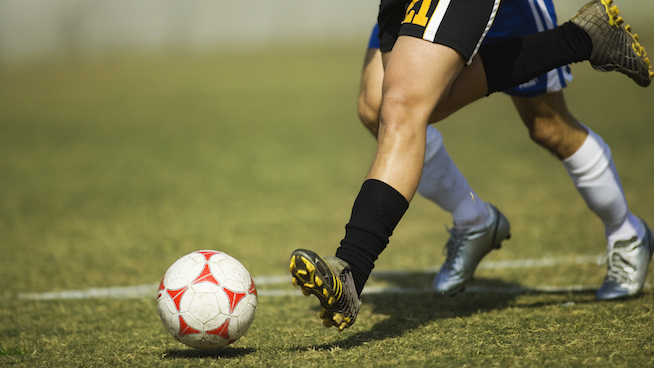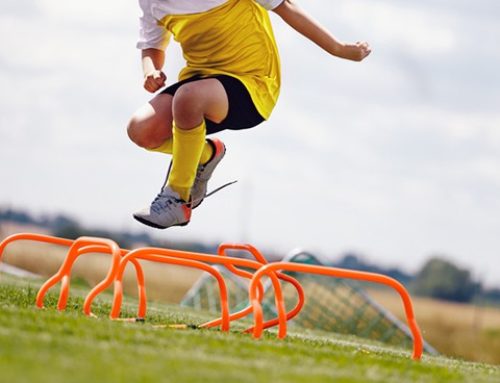3 Biggest Myths About Soccer Speed

Speed wins games. Coaches want it, players respect it, and spectators cheer for it. Unfortunately, soccer speed is often misunderstood. In years of working with everything from AYSO to National teams, I encountered several myths about soccer speed. Here are the three biggest.
Only Speed With the Ball Matters
Of course, being quick with the ball in your possession is a huge part of soccer. That’s skill. That’s the point. However, if you don’t recognize what happens without the ball, you’re missing most of the game.
First off, most of the time players don’t have the ball. Do the math: 90-minute game and 20 field players. If they all had it for equal time (which of course they don’t), that’s 4.4 minutes or 5 percent of the time. So even if you’re a player who gets a lot more possession, you’re going to spend the majority of your time without the ball.
Then you have to think about how you get the ball. Beating an opponent to the ball and creating an open space with a run both require speed.
Finally, although moves in small, tight spaces may require more quickness, if you’re moving in open space, you can’t move any faster with the ball than your body can go. Your sprinting speed is your limit.
Bottom line, if you want to be a fast player, develop your speed.
Fast Players Are Born That Way
Decades ago, many coaches would say “you can’t teach speed”—like there was a genetic lottery to determine whether you have it or not. Not true.
Yes, you need some genetic qualities to have world-class, 100m gold medal speed. If you didn’t have the right grandparents, all the training in the world might not get you there. However, speed is a complex motor skill that involves both motor control and force production capabilities, both of which can be taught and improved through good coaching and training.
If you want to gain an advantage over your competition at every level, you need to maximize your speed. That means training your movement skills and force production capabilities.
Running Sprints Will Make Players Fast
Too often, coaches, players and parents think they are doing speed training. After all, the players are running as fast as they can doing those sprints at practice.
Yes, running at full effort is an important part of developing speed, but it’s not a winning formula.
The formula to improve speed is The Big 4—the four factors you can train and teach to improve speed:
- Generating big force to propel your body
- Applying that force in a very small ground contact time
- Applying the force in the proper direction
- Moving your body through an optimal range of motion
These can all be taught using advanced motor control and neurodevelopmental techniques along with proper functional strength training and mobility development
Do You Want to Be Faster?
If you’ve fallen into one of these traps, you’re not alone. The good news is that you can get an edge on your competition by breaking free and taking control of how fast you will be out on the soccer field. You can start with the drills and tips described in the following articles:
RECOMMENDED FOR YOU
MOST POPULAR
3 Biggest Myths About Soccer Speed

Speed wins games. Coaches want it, players respect it, and spectators cheer for it. Unfortunately, soccer speed is often misunderstood. In years of working with everything from AYSO to National teams, I encountered several myths about soccer speed. Here are the three biggest.
Only Speed With the Ball Matters
Of course, being quick with the ball in your possession is a huge part of soccer. That’s skill. That’s the point. However, if you don’t recognize what happens without the ball, you’re missing most of the game.
First off, most of the time players don’t have the ball. Do the math: 90-minute game and 20 field players. If they all had it for equal time (which of course they don’t), that’s 4.4 minutes or 5 percent of the time. So even if you’re a player who gets a lot more possession, you’re going to spend the majority of your time without the ball.
Then you have to think about how you get the ball. Beating an opponent to the ball and creating an open space with a run both require speed.
Finally, although moves in small, tight spaces may require more quickness, if you’re moving in open space, you can’t move any faster with the ball than your body can go. Your sprinting speed is your limit.
Bottom line, if you want to be a fast player, develop your speed.
Fast Players Are Born That Way
Decades ago, many coaches would say “you can’t teach speed”—like there was a genetic lottery to determine whether you have it or not. Not true.
Yes, you need some genetic qualities to have world-class, 100m gold medal speed. If you didn’t have the right grandparents, all the training in the world might not get you there. However, speed is a complex motor skill that involves both motor control and force production capabilities, both of which can be taught and improved through good coaching and training.
If you want to gain an advantage over your competition at every level, you need to maximize your speed. That means training your movement skills and force production capabilities.
Running Sprints Will Make Players Fast
Too often, coaches, players and parents think they are doing speed training. After all, the players are running as fast as they can doing those sprints at practice.
Yes, running at full effort is an important part of developing speed, but it’s not a winning formula.
The formula to improve speed is The Big 4—the four factors you can train and teach to improve speed:
- Generating big force to propel your body
- Applying that force in a very small ground contact time
- Applying the force in the proper direction
- Moving your body through an optimal range of motion
These can all be taught using advanced motor control and neurodevelopmental techniques along with proper functional strength training and mobility development
Do You Want to Be Faster?
If you’ve fallen into one of these traps, you’re not alone. The good news is that you can get an edge on your competition by breaking free and taking control of how fast you will be out on the soccer field. You can start with the drills and tips described in the following articles:










